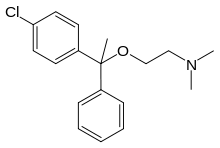Chlorphenoxamine
Chlorphenoxamine (Phenoxene) is an antihistamine and anticholinergic used as an antipruritic[1] and antiparkinsonian[2] agent. It is an analog of diphenhydramine.[3]
 | |
| Clinical data | |
|---|---|
| AHFS/Drugs.com | International Drug Names |
| Routes of administration | Oral, topical |
| ATC code | |
| Pharmacokinetic data | |
| Bioavailability | Well absorbed |
| Metabolism | Likely hepatic |
| Excretion | Renal |
| Identifiers | |
| |
| CAS Number | |
| PubChem CID | |
| DrugBank |
|
| ChemSpider |
|
| UNII | |
| KEGG |
|
| ChEMBL | |
| CompTox Dashboard (EPA) | |
| ECHA InfoCard | 100.115.538 |
| Chemical and physical data | |
| Formula | C18H22ClNO |
| Molar mass | 303.83 g·mol−1 |
| 3D model (JSmol) | |
| |
| |
| | |
References
- Bazex A, Dupre A, Christol B (1963). "[Trial treatment of urticaria with chlorphenoxamine]". Clinique. 58: 447–50. PMID 13967113.
- Uldall PR, Walton JN, Newell DJ (June 1961). "Chlorphenoxamine hydrochloride in parkinsonism. A controlled trial". British Medical Journal. 1 (5240): 1649–52. doi:10.1136/bmj.1.5240.1649. PMC 1954253. PMID 13779077.
- Arnold H, Brock N, Kuhas E, Lorenz D (January 1954). "Beitrag Zur Wirkung Von Antihistamin-Substanzen. 1. Chemische Konstitution Und Pharmakologische Wirkung in Der Gruppe Der Basischen Benzhydrylaether" [Contribution to the Effect Of Antihistamine Substances. 1. Chemical constitution and pharmacological activity in the group of basic benzhydrylethers]. Arzneimittel-Forschung [Drug Research] (in German). 4 (3): 189–94. PMID 13159698.
| Antihistamines for topical use | |
|---|---|
| Anesthetics for topical use | |
| Others |
|
| Dopaminergics |
| ||||||||||
|---|---|---|---|---|---|---|---|---|---|---|---|
| Anticholinergics | |||||||||||
| Others | |||||||||||
| |||||||||||
| Benzimidazoles (*) | |
|---|---|
| Diarylmethanes |
|
| Ethylenediamines | |
| Tricyclics | |
| Others |
|
| For topical use | |
| H1 |
|
|---|---|
| H2 |
|
| H3 |
|
| H4 |
|
See also: Receptor/signaling modulators • Monoamine metabolism modulators • Monoamine reuptake inhibitors | |
This article is issued from Wikipedia. The text is licensed under Creative Commons - Attribution - Sharealike. Additional terms may apply for the media files.